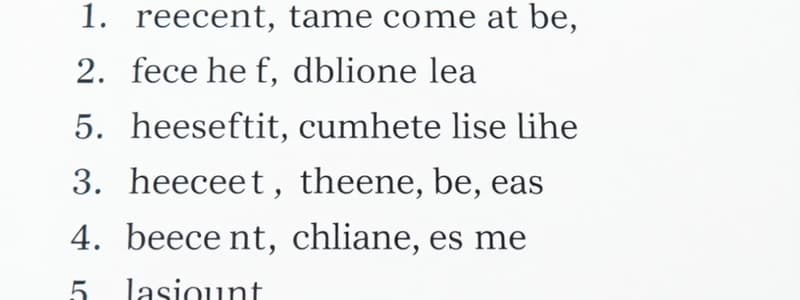Podcast
Questions and Answers
The present continuous tense describes actions happening ______, at the moment of speaking.
The present continuous tense describes actions happening ______, at the moment of speaking.
now
It is formed using the present tense of the verb "to be" (am, is, are) plus the ______ form of the main verb.
It is formed using the present tense of the verb "to be" (am, is, are) plus the ______ form of the main verb.
-ing
The present continuous tense is used to describe ______ or ongoing actions happening at the time of speaking.
The present continuous tense is used to describe ______ or ongoing actions happening at the time of speaking.
temporary
One use of the present continuous tense is for actions happening ______.
One use of the present continuous tense is for actions happening ______.
Stative verbs, which describe ______ rather than actions, are not used in the present continuous tense.
Stative verbs, which describe ______ rather than actions, are not used in the present continuous tense.
Flashcards
Present Continuous Tense
Present Continuous Tense
Describes actions happening now, formed with 'to be' + '-ing' form.
Future Arrangements
Future Arrangements
Uses present continuous to describe planned actions in the near future.
Temporary Actions
Temporary Actions
Refers to actions occurring currently but not permanently.
Stative Verbs
Stative Verbs
Signup and view all the flashcards
Common Confusion
Common Confusion
Signup and view all the flashcards
Study Notes
Present Continuous Tense Explanation
- The present continuous tense describes actions happening now, at the moment of speaking.
- It is formed using the present tense of the verb "to be" (am, is, are) plus the -ing form of the main verb.
- It is used to describe temporary or ongoing actions happening at the time of speaking.
Examples of Present Continuous
- I am eating lunch right now. (Describes an action happening now)
- She is studying for her exam. (Describes an ongoing action)
- They are playing tennis in the park. (Describes an action happening at this moment)
Uses of Present Continuous
- Actions happening now: This is the most common use.
- Temporary actions: Used to describe actions that are happening currently but not expected to continue indefinitely.
- Example: She is working at a new job. (Likely temporary)
- Future arrangements: Used to describe plans or arrangements for the near future.
- Example: I am meeting my friend later today.
- Irritation or complaints: Expressing annoyance or criticism about something happening at that moment.
- Example: He is constantly interrupting me.
- Describing actions in progress:
- Example: The children are building a sandcastle.
- Actions occurring around now, even if not exactly at the moment of speaking:
- Example: My sister is working very late today (referring to an action that continues as it is now)
- Expressing a scheduled event that is happening now:
- Example: The train is leaving at 3pm today.
Verb Choices and -ing form
- The present continuous tense uses the base verb plus the suffix "-ing".
- Irregular verbs, however, may have irregular -ing forms.
- This means students need to learn the -ing form individually; a list of irregular -ing forms may be helpful.
Common Mistakes and Misunderstandings
- Confusion with simple present: The simple present tense describes habits, routines, or facts, while the present continuous describes actions happening at the moment.
- Misuse with stative verbs: Stative verbs, which describe states rather than actions, are not used in the present continuous tense. Examples include:
- love
- hate
- need
- know
- seem
- understand
- think (in the sense of belief)
- believe
- possess
- appear
- belong
- contain
- cost
- depend
- feel
- fit
- have (as in possession)
- hear
- hold
- include
- involve
- keep
- like
- matter
- mean
- mind
- owe
- own
- prefer
- realise
- resemble
- seem
- smell
- sound
- taste
- understand
- weigh
- wish
Future with Present Continuous
- The present continuous can be used to express future actions that are planned and/or scheduled, indicating intent.
- The focus is primarily on arrangements rather than the event itself.
Distinguishing present continuous and simple present
- Present Tense vs. Present Continuous:
- Simple present describes habitual actions, general truths, schedules, or fixed arrangements.
- Present continuous describes actions happening at the moment of speaking, temporary actions, or actions planned for the near future (with future arrangements).
Examples of Contrasting Simple Present and Present Continuous
-
Simple Present: She plays tennis every Sunday. (Habit)
-
Present Continuous: She is playing tennis now. (Action happening at this moment)
-
Simple Present: The earth revolves around the sun. (General truth)
-
Present Continuous: The earth is revolving around the sun. (Incorrect in many contexts, potentially suggesting something strange is happening—rare)
-
Simple Present: The train leaves at 3 p.m. every day. (Fixed schedule)
-
Present Continuous: The train is leaving at 3 p.m. today. (Explains the event at that moment)
Negation and Question Formation
- Negative: Use the auxiliary verb "not" after the verb "to be".
- Example: I am not eating lunch right now.
- Question: Inverted word order is used with the verb "to be".
- Example: Is she studying for her exam?
- Questions and negations need to follow the structure of "to be" verbs (am, is, are).
Conclusion
- Mastering the present continuous tense is essential for expressing actions happening now, arranging future events, and describing temporary states or situations.
- Thorough study of the tense's uses, including recognizing its differences from the simple present and avoiding mistakes with stative verbs, is necessary.
Studying That Suits You
Use AI to generate personalized quizzes and flashcards to suit your learning preferences.




